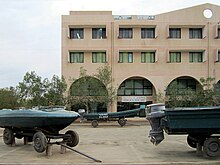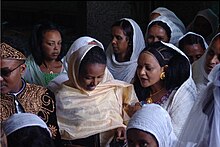This is an old revision of this page, as edited by Middayexpress (talk | contribs) at 15:03, 12 June 2014 (commonalities/ties). The present address (URL) is a permanent link to this revision, which may differ significantly from the current revision.
Revision as of 15:03, 12 June 2014 by Middayexpress (talk | contribs) (commonalities/ties)(diff) ← Previous revision | Latest revision (diff) | Newer revision → (diff)
The culture of Eritrea has been largely shaped by its location on the Red Sea coast. It shares historic commonalities with the traditions of Ethiopia, Somalia, Djibouti and Sudan, and also has ties with the Near East and Italy. The local culture consists of various, and often quite similar, traditions practiced by the nation's many Cushitic and Semitic-speaking Afro-Asiatic ethnic groups, in addition to those practiced by the area's Nilotic minorities. Eritrea's semi-arid terrain in the northeastern Sahel and its unique climate have also been important influences on local customs.
Coffee ceremony

One of the most recognizable parts of Eritrean culture is the coffee ceremony. Coffee (Ge'ez ቡን būn) is offered when visiting friends, during festivities, or as a daily staple of life. If coffee is politely declined then most likely tea ("shai" ሻሂ shahee) will be served. The coffee is brewed by first roasting the green coffee beans over hot coals gughin a brazier. Once the beans are roasted each participant is given an opportunity to sample the aromatic smoke by wafting it towards them. The coffee roasting smoke are sometimes used to fill the rooms with a pleasant scent. This is followed by the grinding of the beans, traditionally in a wooden mortar and pestle.
The coffee grounds are then put into a special vessel, called a jebena, and boiled. A jebena is usually made of clay and has a spherical base, a neck and pouring spout and a handle where the neck connects with the base. When the coffee boils up through the neck it is poured in and out of another container to cool it, and then is put back into the jebena until it happens again. To pour the coffee from the jebena a filter made from horsehair or other material is placed in the spout of the jebena to prevent the grounds from escaping.
The host pours the coffee for all participants by moving the tilted jebena over a tray with small, handleless cups (finjal) without stop until each cup is full. Some of the coffee will inevitably miss the cup but this is done to prevent the coffee grounds from contaminating the brew. One extra cup is poured each time. The grounds are brewed four times: the first round of coffee is called awel, the second kale'i, the third bereka ('to be blessed')and the fourth is called "dereja". However, the "dereja" is not always poured, it is mostly poured when elders are present. The coffee ceremony may also include burning of various traditional incense such as frankincense or gum arabic.
Cuisine
Main article: Eritrean cuisine
Typically, Eritrean cuisine consists of various stews (tsebhi) made from vegetables and meat, and served atop a large, flat sourdough bread called injera or tayta. Many vegetarian dishes are available since a majority of the population observe fasting at some time during the year. Eating is accomplished without utensils by tearing a piece of injera (strictly using the right hand), then scooping some stew, vegetables or salad with the bread.
On visiting an Eritrean household, it is polite to decline at least three times if asked to dine. Usually the host will say "bezay kelalem", after which the guest may agree to dine. This process ensures that one does not seem too eager to eat at another's household. When one visits an Eritrean house regardless of whether they are served with food or not, they are always served with hot tea.
Music
Main article: Music of Eritrea
Eritrea has nine ethnic groups, each of which have their own different styles of music and accompanying dances. A common instrument used by many of the communities is the drum. Amongst the Tigray-Tigrinya, the best known traditional musical genre is called guaila.
Religion
Main article: Religion in Eritrea
It is estimated that 50% of the population of Eritrea is Christian, mostly belonging to the Oriental Orthodox tradition of the Eritrean Orthodox Tewahedo Church, and the other 50% is Sunni Muslim or Sufi. The rest of the population practice traditional Indigenous religions, and Roman Catholic, while others include Protestants, Seventh-day Adventists, Jehovah's Witnesses, and Baháís.
Christianity
Christianity accounts for 50% of the population.
Eritrean Muslims and Christians have a mutual respect for each other.
Islam
Islam accounts for approximately 50% of the population.
All Eritrean Muslims practice Sunni Muslim or Sufism. Generally, the eastern and western lowlands are predominantly Muslim while the highlands are predominantly Christian.
See also
References
- Tekle, Amare (1994). Eritrea and Ethiopia: From Conflict to Cooperation. The Red Sea Press. p. 197. ISBN 0932415970.
Djibouti, Eritrea, Ethiopia, Somalia and Sudan have significant similarities emanating not only from culture, religion, traditions, history and aspirations but also from being in comparable levels of income and economic development. For the most part, the peoples of these countries share common values. They appreciate similar foods and spices, beverages and sweets, fabrics and tapestry, lyrics and music, and jewelry and fragrances. They even compare in sizes and looks and are hard to tell.
- It’s coffee time Network Africa Online, April 2008 interview.
- ^ International Religious Freedom Report 2007: Eritrea. United States Bureau of Democracy, Human Rights and Labor (September 14, 2007). This article incorporates text from this source, which is in the public domain.
| Culture of Africa | |
|---|---|
| Sovereign states |
|
| States with limited recognition | |
| Dependencies and other territories |
|
| Eritrea articles | |||||
|---|---|---|---|---|---|
| History |  | ||||
| Geography | |||||
| Politics | |||||
| Economy | |||||
| Culture |
| ||||